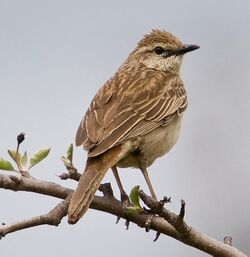Biology:Cincloramphus
From HandWiki
Short description: Genus of birds
| Cincloramphus | |
|---|---|

| |
| Rufous songlark (Cincloramphus mathewsi) | |
| Scientific classification | |
| Domain: | Eukaryota |
| Kingdom: | Animalia |
| Phylum: | Chordata |
| Class: | Aves |
| Order: | Passeriformes |
| Family: | Locustellidae |
| Genus: | Cincloramphus Gould, 1838 |
| Type species | |
| Megalurus cruralis[1] Vigors & Horsfield, 1827
| |
| Synonyms | |
|
Megalurulus Verreaux, J, 1869 | |
Cincloramphus is a genus of birds in the grassbird family Locustellidae.
The genus Cincloramphus was introduced by the English ornithologist and bird artist John Gould in 1838 with the brown songlark as the type species.[2][3] The name combines the Ancient Greek kinklos meaning "thrush" with rhamphos meaning "bill".[4]
A comprehensive molecular phylogenetic study of the family Locustellidae published in 2018 found that many of the genera were non-monophyletic. In the resulting reorganization the genera Megalurulus and Buettikoferella became junior synonyms of the resurrected genus Cincloramphus.[5][6]
The genus now contains 12 species:[6]
- Brown songlark (Cincloramphus cruralis)
- Rufous songlark (Cincloramphus mathewsi)
- Rusty thicketbird (Cincloramphus rubiginosus)
- New Britain thicketbird (Cincloramphus grosvenori)
- Buff-banded thicketbird (Cincloramphus bivittatus)
- Papuan grassbird (Cincloramphus macrurus)
- Tawny grassbird (Cincloramphus timoriensis)
- Guadalcanal thicketbird (Cincloramphus turipavae)
- Santo thicketbird (Cincloramphus whitneyi)
- New Caledonian thicketbird (Cincloramphus mariae)
- Long-legged thicketbird (Cincloramphus rufus)
- Bougainville thicketbird (Cincloramphus llaneae)
References
- ↑ "Locustellidae". The Trust for Avian Systematics. https://www.aviansystematics.org/4th-edition-checklist?viewfamilies=251.
- ↑ Gould, John (1838). A Synopsis of the Birds of Australia, and the Adjacent Islands. London: self. Part 4, p. 4. https://biodiversitylibrary.org/page/47441775.
- ↑ Mayr, Ernst; Cottrell, G. William, eds (1986). Check-list of Birds of the World. 11. Cambridge, Massachusetts: Museum of Comparative Zoology. p. 44. https://biodiversitylibrary.org/page/14483745.
- ↑ Jobling, James A. (2010). The Helm Dictionary of Scientific Bird Names. London: Christopher Helm. p. 107. ISBN 978-1-4081-2501-4. https://archive.org/stream/Helm_Dictionary_of_Scientific_Bird_Names_by_James_A._Jobling#page/n107/mode/1up.
- ↑ Alström, P.; Cibois, A.; Irestedt, M.; Zuccon, D.; Gelang, M.; Fjeldså, J.; Andersen, M.J.; Moyle, R.G. et al. (2018). "Comprehensive molecular phylogeny of the grassbirds and allies (Locustellidae) reveals extensive non-monophyly of traditional genera, and a proposal for a new classification". Molecular Phylogenetics and Evolution 127: 367–375. doi:10.1016/j.ympev.2018.03.029. PMID 29625229. https://zenodo.org/record/2587007.
- ↑ 6.0 6.1 Gill, Frank; Donsker, David; Rasmussen, Pamela, eds (August 2022). "Grassbirds, Donacobius, Malagasy warblers, cisticolas, allies". IOC World Bird List Version 12.2. International Ornithologists' Union. http://www.worldbirdnames.org/bow/grassbirds/.
Wikidata ☰ Q15032474 entry
 |

